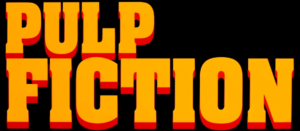Quotations, diverse mix of genres, a handful of obsessions, and a significant dose of extravagance: these are the hallmarks of Quentin Tarantino’s style, which unmistakably extends to the typography featured in the opening credits of his films. How many other directors could seamlessly incorporate four distinct font styles within a span of mere seconds, as seen in Kill Bill? Additionally, there are nods to the typography of spaghetti westerns, borrowing fonts from 1970s B-movies, and certain typefaces that recur throughout nearly every film.

In essence, even in terms of typography, the maestro of American cinema consistently captivates us. Presented here is a compilation showcasing examples of the most iconic opening credits from Tarantino’s legendary films.
Reservoir Dogs
Reservoir Dogs, Tarantino’s debut film, was crafted on a shoestring budget, to the extent that some actors had to provide their own wardrobe and vehicles for scenes. Perhaps it’s this aspect that lends the film its distinct charm, somewhere between amateur and classic cop flick. This vibe is evident right from the opening credits.

http://annyas.com/
The characters are captured in slow motion during their now-famous walk, accompanied by their names displayed on screen in Palatine font, tinted in a mustard hue that would become a signature for many of Tarantino’s subsequent films. A 1970s hit sets the rhythm in the background. The film’s title is rendered in the timeless Garamond font, another elegant typeface with origins dating back to 16th century France and having undergone various modifications since. Interestingly, it holds a notable record in Italy, as we’ve detailed previously.
As the credits roll smoothly and rhythmically, the soundtrack hints at a shift: the music fades, replaced by eerie wails in the backdrop. Do you recall who’s in trouble?
Pulp Fiction
Arguably Tarantino’s most famous work, Pulp Fiction marks the beginning of a notable collaboration between the director and Pacific Title, a Hollywood company specializing in title design since the silent film era. Pacific Title, and their designer Jay Johnson in particular, would go on to handle the graphic design of titles for all of Tarantino’s subsequent films.

http://annyas.com/
After presenting the definition of “pulp” according to the American Heritage Dictionary in classic Times New Roman, the opening sequence sets the stage for what unfolds over the next two hours: gritty dialogue, nefarious intentions, and nods to 1970s culture.
The initial credits feature ITC Busorama , a sans serif font created by Tom Carnase in 1970 that merges art deco with a quirky style. The iconic film title emerges powerfully from the bottom in the 1969 Aachen Bold font. Overlaid in white are the actors’ credits, likely in a modified form of ITC Benguiat, a graceful font designed by Ed Benguiat in 1977, which also finds its place in the logo of a certain television series.
Then, someone switches the radio station, and we find ourselves in a Chevrolet with John Travolta and Samuel L. Jackson.
Jackie Brown
Tarantino’s films abound with references: underground cinema, Italian poliziotteschi, and B-movies. In Jackie Brown, the director’s third and perhaps least-known film, everything, including the typography of the title, pays homage to blaxploitation films.

The film’s title accentuates the funky vibe with ITC Tiffany font, another creation by Ed Benguiat in 1974. The primary inspiration is the poster for Foxy Brown, a 1974 blaxploitation film starring the same leading lady handpicked by Tarantino: Pam Grier. Even the typeface used for the Foxy Brown logo is the work of Ed Benguiat: the Benguiat Caslon.
Inglourious Basterds
The use of fonts in the opening credits of Tarantino’s films often mirrors his filmmaking style. And if there’s one thing Tarantino enjoys, it’s making appearances in his own films. His cameos are numerous: in Pulp Fiction, he finds himself in a predicament with John Travolta and Samuel L. Jackson, while in Reservoir Dogs, he’s part of the gang of thugs.

Somehow, even in the opening credits of Inglourious Basterds, the director’s sixth film, there’s a cameo by him. In fact, the film’s title is penned in his own handwriting, taken from the cover of his final screenplay completed in July 2008.
The Hateful Eight
Quentin Tarantino’s pair of western films presents a delightful opportunity to unearth some spaghetti westerns, even from a typographic standpoint.

The typeface utilized for The Hateful Eight’s title – Tarantino’s eighth endeavor – was crafted by Jay Johnson, drawing inspiration from a plethora of spaghetti westerns! Specifically, the title’s whimsical lettering evokes the works of Iginio Lardani, often dubbed the “Sergio Leone” of title design, renowned for crafting the genre’s most iconic introductions. Moreover, the actor credits, displayed in mustard-colored ITC Bookman font, serve as a gentle reminder – if it wasn’t already apparent – that we are indeed indulging in a Tarantino production.
Once Upon a Time in Hollywood
Tarantino’s most recent cinematic offering serves as a tribute to Hollywood, straddling the line between homage and nostalgia: vintage attire, classic automobiles, retro posters, and an abundance of vintage typography.

Among the film’s highlights – particularly for enthusiasts like us – is the scene where the illuminated signs of Hollywood gradually flicker to life, offering thirty seconds of pure immersion in 1960s graphic design!
But let’s delve into the opening credits. Once Upon a Time in… Hollywood commences, and we’re greeted with the familiar sight of ITC Bookman and ITC Busorama fonts, in their signature mustard hue. Interestingly, the film’s title only makes its appearance during the end credits, perhaps symbolizing the conclusion of this contemporary fairy tale.
In conclusion, Tarantino’s typographic selections are seamlessly intertwined with his filmmaking style, enhancing his distinct and now iconic cinematic oeuvre. From recurring elements like Bookman and Busorama to fonts that pay homage to entire aesthetic movements, such as the Western genre or the funky vibe of Jackie Brown, there’s a palpable sense of Tarantino’s personal touch in every letter.

